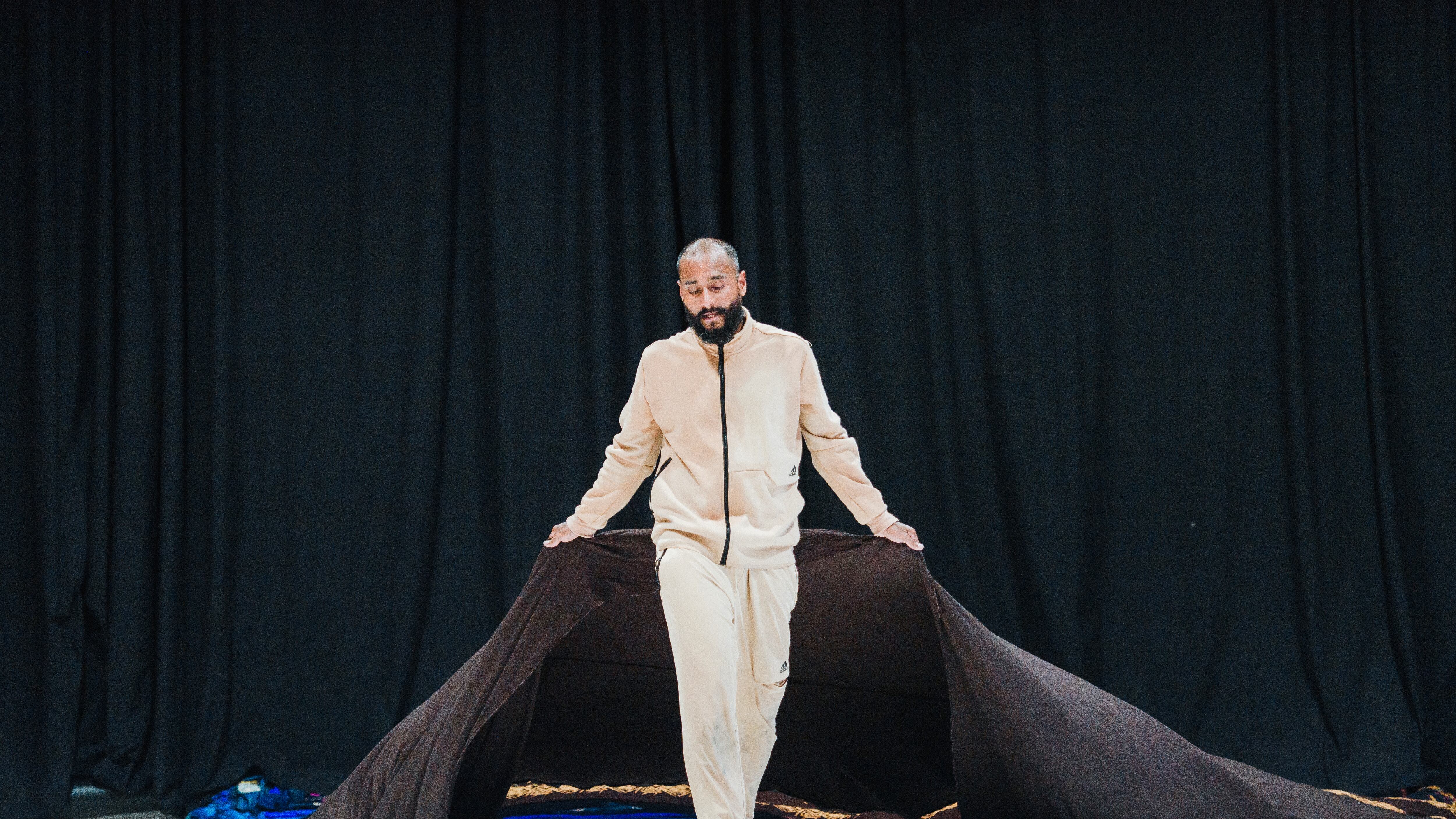Rakesh Sukesh’s smile is warm and radiant throughout his narrative contemporary dance program because i love the diversity (this micro-attitude, we all have it), even when the stories he shares are not.
The Portland Institute of Contemporary Art and Boom Arts brought Sukesh to PICA’s warehouse venue on Northeast Hancock Street for five performances around the weekends of April 12–19. On Thursday, April 17, about five dozen audience members watched Sukesh bound proudly onto long white foam gym pads. Pacing jovially in a beige Adidas tracksuit and offering a few saluting how-you-doin’ hip thrusts, Sukesh introduces himself with a brief biography.
He points out with his feet a “map” of his home and pictures of his family on a plain, featureless piece of brown cloth hidden behind a black curtain. Born in India, Sukesh fell in love with dance at an early age and, at his family’s behest, entered the film industry. Unable to stand the dark side of Bollywood, Sukesh saw a future for himself in contemporary dance after seeing a performance.
Inspired, Sukesh trained and studied until his first trip to Europe, which led to more European trips, then to Asia and North America to perform and train students. He revealed later that he did not have his family’s support to leave, later playing and translating a voice message from his mother guilting and shaming him for leaving their family and his Bollywood career.
But still fascinated by what he sees on each trip, Sukesh gestures with his arms while calling out the names of countries he’s visited: Switzerland, Belgium, Canada, China, Russia, Estonia—his arm gets caught, his hand clutching at something he doesn’t want to touch but can’t let go of. The story stops as Sukesh, still outwardly warm, tries to free himself. He struggles, maneuvering as though shadow boxing with one arm tied behind his back. When he finally does, his spirits drop. He then shares a story.
Sukesh was waiting to cross the street one day while teaching as an invited guest at an Estonian university. He noticed a man recording him, but didn’t think anything of it until a friend told him that the video was being circulated in far-right political circles and content farms as yet another example of foreigners taking up space and stealing jobs.
The experience injured his spirit, but it’s not the entire point of because i love diversity just as that moment doesn’t erase Sukesh’s expertise. The incident makes Sukesh recall other times when he’s been racially discriminated against, like when he was confused for an Uber delivery driver while waiting in a restaurant for his girlfriend, or when a different girlfriend’s Spanish-speaking relative elicited laughter for referring to him as “azul” instead of “negro” while expressing wariness around their relationship.
Clownery helps Sukesh both balance the mood of his show and emphasize his points. Using the two aforementioned stories involving his exes, Sukesh repeatedly pokes fun at himself for being unlucky in love. He recounted how a well-meaning colleague told him to channel his feelings around the Estonian harassment into a “sophisticated” dance piece. Instead of expressing the offense he rightly felt at his style of dance implicitly being called unsophisticated, Sukesh says “sure, why not,” pivoting to a mock run-through of a Swan Lake sequence.
Most ballet parody is only as deep as a man in a tutu trying to be dainty, but his intentional sloppiness in ballet form reads like someone who’s studied the art and knows when to keep form and when to break the rules for humor.
Despite his frustration and fury, Sukesh’s artistry helps the Western world realize the sophistication and grace of Indian culture, which is rarely taught alongside the Renaissance greats. It’s not black pepper and Downward Dog to him, but kali mirch and Adho Mukha Svanasana. He’s not turning on the social justice sirens, but asking artistic audiences and institutions to respect the diversity they say they want.
A recording of a woman’s waffling voice in one sequence talks reluctantly about “liking diversity, but…,” trailing off on a well-worn path of racist tropes about brown men irresistibly lusting after her white flesh. Most artistic worlds are still surprisingly homogenous, and even the most well-meaning allies can make people like Sukesh feel like freaks or “less than” for being who they are. But Sukesh doesn’t dull his shine. He engages strangers with high-esteem hospitality like his mother taught him, feeding the audience from six pizzas—he says he didn’t know where in Portland to find good Indian food like his mother’s biryani, which leads to a story in which someone refused to let him compare the “rice and things” dish to paella.
After playing his mother’s voice message, Sukesh returns to the black curtain and the brown fabric “map.” Pulling the curtain back, the brown cloth is only one layer of a massive tapestry of richly colored and detailed fabrics sewn together—the part visible earlier is indeed at the southern end of the compass rose, just as he said when pointing to his family on the subcontinent’s southern end.
He strips from his sweat-through track suit down to the nude (it was unclear at Thursday’s performance whether he was supposed to have a hanger to hang the suit upon or there was a technical malfunction that read like circus humor), tears off a piece of brown fabric and makes himself a loincloth. He sinks beneath the cloth waves, wearing it as a veil, then picking up excess textiles and dancing back to the curtain with them, never overencumbered and still able to animate the material.
The fabric continues to tussle as it reaches the wall, as though Sukesh is still fighting beneath it. But he comes back from behind the curtain. The fight’s still going on, but he’s separated himself from it. He’s free again, as proud as he should be, his smile beaming in the dark.
